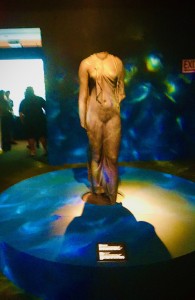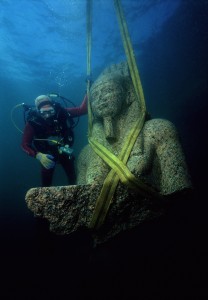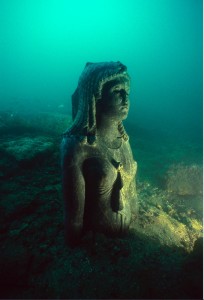Cultural Cocktail Hour
Review: “Egypt’s Lost Cities” at the Reagan Library- MUST-SEE exhibit
Review: “Egypt’s Lost Cities”
Uncovering an archaeological mystery
at the Ronald Reagan Presidential Library
On View Until April 12, 2020
by
Leticia Marie Sanchez
The exhibit “Egypt’s Lost Cities” is intriguing for many reasons. Firstly, the exhibit takes the viewer on a journey to see the forgotten ancient cities of Thonis-Heracleion and Canopus, which were discovered by mathematician-economist Franck Goddio and his team of underwater archaeologists. Secondly, the blockbuster exhibition at the Reagan Library contains an astonishing treasure trove of more than 200 artifacts, including gold coins, bronze vessels, jewelry, ceramics, statues of Cleopatra III, and Ptolemy XII as a Sphinx. The works are exceptionally intact, despite having been buried under the sea for more than two thousand years. Prior to the founding of Alexandria in 331 B.C. the harbor of Thonis-Heracleion controlled all the trade into Egypt and was the Venice of its time.
In addition to the abundance of objects unearthed by his team. Franck Guido’s discovery answered a question that had mystified Egyptologists for ages. What was Thonis-Heracleion? The archaeological material demonstrated that Heracleion and Thonis were in fact one and the same city, but with two different names; Heracleion being the name of the city for the Greeks and Thonis for the Egyptians. Before Guido’s work solved the mystery, the cities’ names had only been rarely seen: on inscriptions found on land by archaeologists or in ancient classic texts. For instance, the Greek historian Herodotus (5th Century BC) mentioned the city as the spot where the famous hero Herakles once set foot. The exhibition brings to light a civilization that time forgot.
What is remarkable is that the discovery is less than five percent of the treasures pertaining to Thonis-Heracleion that remain buried in the ocean. One can only imagine the world of splendor that lies beneath the sea. The exhibit is truly a time capsule of a civilization that had long been forgotten.
Photo: © 2019 Leticia Marie Sanchez
The bust of the colossal statue of Hapy has been strapped with webbings before being cautiously raised out of the water of Aboukir bay, Egypt Photo: Christoph Gerigk
© Franck Goddio / Hilti


Cleopatra III. Bust of the black stone queen set up underwater. Heracleion. Ptolemaic Period, granodiorite, H. 220 cm. National Museum, Alexandria. SCA 283. IEASM Excavations.
Photo: Christoph Gerigk © Franck Goddio / Hilt Foundation


Ptolemy XII as a Sphinx
Archeologist eye to eye to with a sphinx
underwater. Granodiorite. H. 70, L 150 cm. 1st c. BC. National Museum, Alexandria (SCA 450) Alexandria Eastern Harbour. IEASM Excavation. The treatment of the face is characteristic of royal effigies blending the Pharaonic traditions with the Hellenistic portrait style. This Sphinx could be a portrait of the father of Cleopatra VII, the “great” Cleopatra, Ptolemy XII Auletes Neos
Dionysos. Photos: Jérôme Delafosse©Franck Goddio/Hilt













